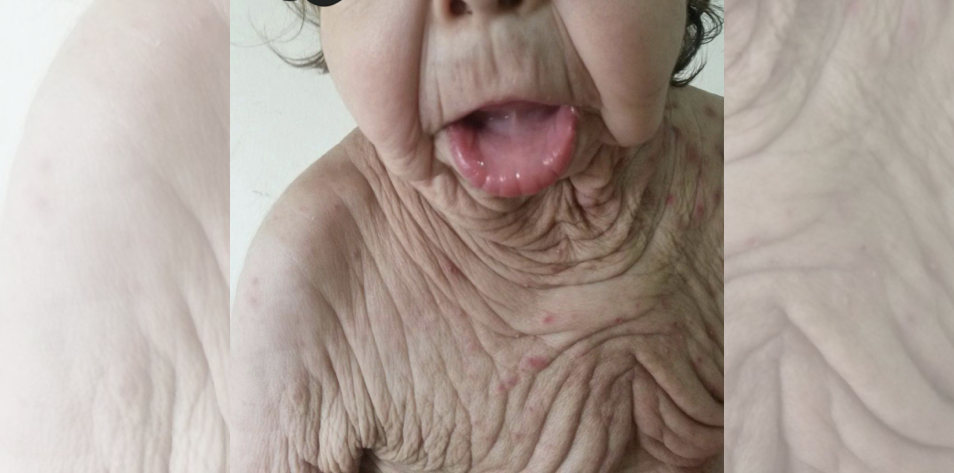
A 3-year-old child presents with sagging skin, pronounced nasolabial creases, ectropion, and a drooping lower lip likely due to a connective tissue disorder. The patient’s sister, who has a similar presentation, passed away at 8 months. A diagnosis of cutis laxa, a rare disease of the connective tissue is suspected.
The diagnosis is based on the images, case presentation, and the report of a sister with a similar presentation. Cutis laxa is a group of rare connective tissue diseases, resulting in loose, redundant, hypoelastic skin tissue, leading to a prematurely aged appearance. The alteration can be either generalized or localized to a specific region, and tissue biopsies show reduction and degeneration of dermal elastic fibers.
Understanding Cutis Laxa
Cutis laxa might have a genetic cause due to mutations in different genes, primarily due to mutations in the Elastin gene, but other genes such as ATPA7 might present altered, therefore, genetic analysis is important to reach a precise diagnosis.
The severity of this condition might be related to fatal pulmonary involvement, digestive and urological alterations, or vascular disturbances. In this regard, patients with only cutaneous involvement might have a good prognosis, but internal organ involvement, especially pulmonary impairment, is associated with a poor prognosis.
Treatment and Management
Unfortunately, there is no specific treatment for this condition or to prevent its progression. Plastic surgery might be an option to treat some extracutaneous manifestations.
The journey of managing a rare disease like cutis laxa not only poses physical challenges, but it can also significantly impact the mental health of both the affected individual and the caregivers. The potential for social isolation and the frequent lack of understanding from others can contribute to anxiety or depression. The caregivers might also experience stress and uncertainty around treatment access as they navigate the complexities of managing a rare condition.
This case of cutis laxa illustrates some of the challenges faced by people living with rare diseases. The stigmatization of such conditions intensifies the difficulties faced by affected individuals. Rare diseases like cutis laxa often lack wide awareness, contributing to delays in recognition by both healthcare providers and families. In this regard, initiatives aiming to increase awareness about rare diseases and combating stigma are crucial for increasing understanding, facilitating early diagnosis, and improving overall care and support.
References
Berk DR, Bentley DD, Bayliss SJ, Lind A, Urban Z. Cutis laxa: a review. J Am Acad Dermatol. 2012 May;66(5):842.e1-17. doi: 10.1016/j.jaad.2011.01.004. Epub 2012 Mar 2. PMID: 22387031.
Gara S, Riley CA, Litaiem N. Cutis Laxa. [Updated 2022 Sep 12]. In: StatPearls [Internet]. Treasure Island (FL): StatPearls Publishing; 2024 Jan-. Available from: https://www.ncbi.nlm.nih.gov/books/NBK532944/
Figure 1 – The future of medical education [Internet]. [cited 2024 Aug 7]. Rare Disease Diagnosis and Treatment Challenges. Available from: https://app.figure1.com/cme/69d87324-dc37-43ef-81e0-1e6428f69592
Published August 7, 2024
Want more clinical cases?
Join Figure 1 for free and start securely collaborating with other verified healthcare professionals on more than 100,000 real-world medical cases just like this one.